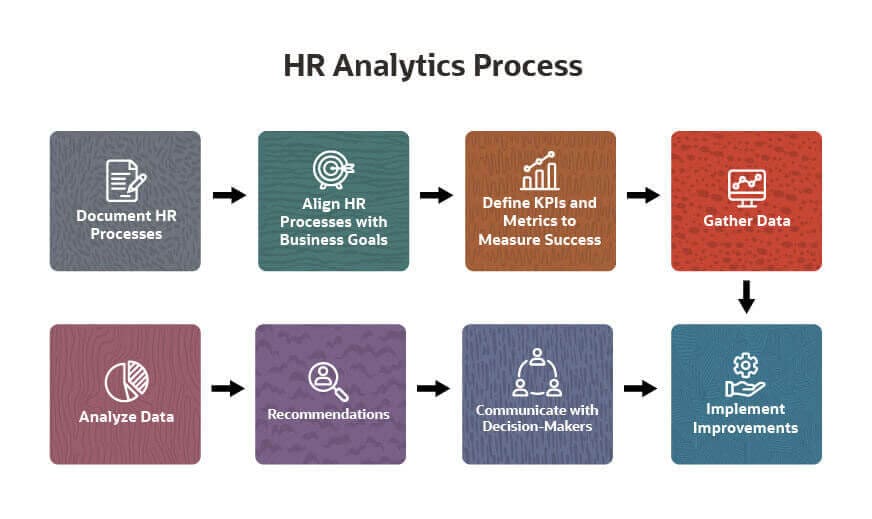We share why it is critical to analyze human resource data to improve HR processes and make better decisions on attracting and retaining top talent. Discover the leading HR analytics to improve performance and productivity. Find templates, examples, and tips to help you get started.
In this article:
- 10 Key HR analytics metrics
- HR analytics dashboard example
- HR analytics dashboard template
- Report template for HR analytics
What Is Human Resources Analytics?
Human resources (HR) analytics is the study of a company’s HR processes using hiring, recruiting, salary and other HR data. You can use the resulting insights to influence process improvement decisions.
Why is HR analytics important?
The demand for data-driven insights for all aspects of business operations is increasing — including in HR. Monitoring and analyzing HR data can help your company find, hire and retain the high performing employees who are good fit with your company culture. HR data can also identify employee engagement opportunities.
How does HR analytics drive business value?
HR analytics helps management monitor employee performance and engagement. A business can use this data to implement improvements that ultimately increase productivity and employee longevity. HR analytics are also used to assess HR processes in order to streamline HR service delivery and lower operational costs. Finally, HR analytics can provide statistics to be used as a benchmark against companies of similar size or industry.
There are several terms used interchangeably with HR analytics. Some organizations refer to it as people analytics, workforce analytics or HR analytics. There is not a right or wrong phrase, as they all intend to produce insights from work. In some instances, mature organizations may split analytics across these categories. In that case, people analytics refers to people data that extends beyond the business, such as employee well-being. HR analytics focuses on HR processes, such as hiring and recruitment. Workforce analytics does not necessarily focus on the person, rather on work processes, even automated ones. This data is useful in workforce management.
Key Takeaways:
- Artificial intelligence-driven solutions are making advanced HR analytics more accessible than ever.
- The data necessary for performing HR process analysis comes from several internal and external sources.
- Tracking key metrics can help you identify areas for improvement, such as turnover and training efficacy.
- Staying ahead of the competition requires predictive HR analytics to attract and retain top talent.
How Do HR Analytics Work?
How are your investments in HR contributing to your revenue, cost cutting and other strategic business areas? Companies who want to understand the impact of HR efforts, improve HR processes and understand employee productivity and engagement are implementing HR analytics.
How to get started with HR analytics
What are HR analytics? Working with HR analytics involves identifying what to measure, selecting key performance indicators (KPIs) and using the resulting analysis to make data-informed decisions. Comparing your findings with industry data can help you benchmark your own performance and better understand HR trends.
The first step in HR analytics is to understand existing processes and business objectives. This is often done through human capital management, which is a set of policies and practices to help you hire, develop and optimize your workforce. Once you know how the department works and its goals, you should decide what business questions you want to answer. Using those questions as a guide, you’ll select KPIs to help you track progress as you work toward these objectives.
For example, a more efficient recruitment process and lowering recruiting costs and improving employee retention may be an overall goal for your HR department and company. In this case, some important KPIs to track would be the cost of recruiting. A common way to track this is with the cost per hire (CPH) metric. To start, you’ll need to gather accurate data so you have accurate results. Costs that go into recruiting could be things like job postings, recruiters' salaries, job fairs and other efforts. The data may come from one or multiple repositories. In which case, your analytics tool would need extraction, transformation and loading (ETL) capabilities to help avoid duplicate data.
In this example, after your data is gathered and structured, you may notice that recruitment costs have increased year-over-year. Rather than simply guessing as to why costs are going up, you can drill down into the details, and you may find that increased prices for job posting is driving the bump. Or maybe, you can see that turnover has gone up each year, meaning more recruitment activities and costs. Whatever the case may be, you can continue digging through the analytics until you find answers and can develop a plan to address the rising costs.
Compare your findings with industry HR statistics as part of your analysis. You may learn that even though your recruiting costs have gone up, they align with similar businesses your size.
At this point, you can share your findings with management and team members, along with recommendations for how to address the issue. In the recruitment costs example, if job posting costs are increasing, you could try identifying only the most excellent job boards that result in the most qualified candidates and focusing your spend. Or, maybe you shift focus and work to boost referral hiring from employees by offering pay or other incentives. Be sure to include the details behind the data and how you came to your conclusions.

What Are HR Analytics Tools?
Massive amounts of data are generated by business activities across your enterprise. And HR is no different. Data can be collected and analyzed from hiring, retention and other efforts. But what tools are best to help with this analysis? Any tool that can help you organize, structure and gain insight from this data can be an analytic tool. A basic spreadsheet of data you use to generate graphs and tables about HR functions is technically an analytics tool.
However, while some spreadsheet tools can give you rudimentary insight, many organizations can benefit from more powerful analytics tools, such as human capital management (HCM) software. Some of the benefits of HCM software include the ability to predict productivity, improve labor force organization and demonstrate ROI from HR efforts. It can show how policy, structure, recruitment and other HR-related efforts impact everything from morale, to performance and retention.
10 Top HR Analytics Metrics
To improve processes and performance, set goals and track progress using metrics such as time-to-hire and revenue-per-employee. These metrics provide business intelligence for HR teams, management and other areas across your business.
1. Revenue per employee (RPE)
Revenue per employee looks at the amount of revenue over a particular period — usually a year — compared to the number of employees. Some variations on this KPI include net income per employee — where expenses and expenditures are subtracted from revenue — and sales per employee — where only revenue from sales is included in the formula. Revenue per employee is one of the most popular HR measurements.
Revenue per employee (RPE) = Total revenue in a given period / Current number of employees in the same period
2. Human capital risk (HCR)
Do you have enough employees to fill demand? Do you have enough employees with the skills and experience to take over vacant leadership roles? What about succession plans for if key workers leave the company? Human capital — or employees — can greatly impact your company’s success, and there is some risk and unknowns inherent with managing your workforce. Rather than one single metric, human capital risk analysis examines several KPIs related to not meeting business goals. This selection of metrics includes turnover rate, absence, employee satisfaction and more.
3. Absenteeism rate
The absenteeism rate looks at unplanned missed workdays over a specific period. For example, a sick day contributes to the absenteeism rate, where planned vacation time using paid time off that’s approved in advance does not.
Absenteeism rate = (Total # of unplanned absences / total time period) x 100
4. Involuntary turnover rate
This KPI tracks the number of employees who are terminated. This would include layoffs and involuntary terminations — aka getting fired. However, employees who leave on their own volition are not included in this calculation. This metric can be a reflection of hiring processes to try and bring on the right candidate for the position, as well as workforce management efforts.
Involuntary turnover rate = (# of employees who involuntarily left the company over a given period / average number of employees in the same period) x 100
5. Voluntary turnover rate
Voluntary turnover accounts for when employee choose to leave their jobs. High voluntary turnover can be costly to businesses. Track this metric to better understand the effect of retention efforts. High turnover can be indicative of one or a combination of several issues, including insufficient salary, poor company culture and a subpar benefits plan.
Voluntary turnover rate = (# of employees who voluntarily leave the company in a given period / average number of employees) x 100
6. Training efficiency
Employee training programs can boost output, improve customer satisfaction and upskill workers. Customers benefit from employees who are better at their jobs and know how to provide excellent service. And companies benefit from improved efficiency.
The Kilpatrick Model, developed in the late 1950s, set standards for evaluating whether training was making a difference for organizations, staff and management. The four levels of the Kilpatrick Model are reaction, learning, behavior and results. If participants find the training relevant, they will acquire the intended skills and apply them to their job, and the training achieves the desired results, then the training is efficient.
Training efficiency is measured with multiple metrics, including skills and competency test scores, output, customer satisfaction and the progression of employees’ career path within your company.
7. Training expenses per employee
Tally up all the expenses to train employees, including software licenses, space rental, training personnel salary and any other cost incurred. Compare results in improved customer and employee satisfaction, boosted sales and greater efficiency to the training expenses to see your return on investment when it comes to training.
Training expense per employee = Total training costs / total number of employees who received training
8. Offer acceptance rate (OAR)
How often do candidates accept your employment offer? This can reflect on your hiring processes, as well as your pay and benefits package and the reputation among potential hires. A variation on this rate is how often employees accept the first offer made without negotiating for better pay or other benefits.
Offer acceptance rate (OAR) = (# of accepted offers / total number of offers during the same period) x 100
9. Time to hire
After your hiring process is complete, look at how long it took from the time the person you hired submitted his/her application or was otherwise sourced for the position and when the new employee begins working. This metric gives insight into the experience for potential recruits. A long time to hire can result in lost qualified candidates who are snatched up by other, more efficient hiring processes.
Time to hire = # of days elapsed from time job is posted to first day on the job
10. Time to fill
Similar to the time to hire KPI, this metric instead looks at how long from the time a position is vacant or a new role is approved to when that role is filled. This metric includes the time it takes to write a job description, post the job, source candidates, conduct interviews and extend an offer. Shortening the time to fill ratio can improve recruit satisfaction, source more qualified candidates and boost productivity by filling vacant roles.
Time to fill = # of days job positions are open / total # of job positions open
For example, if you hire for three open roles, and it took 30, 40 and 50 days to fill, the time to fill is 30+40+50/3 = 40 days. A competitive time to fill varies by industry and roll, but a ballpark figure might be around 35-45 days.
HR Analytics Dashboard
How is analytics used in HR? There are dozens of KPIs, metrics and reports that can give you insight into the processes and performance of your HR-related activities. But to gather this information, structure it and find meaningful information is best done with HCM software. With powerful cloud-based tools, all corresponding HR data is stored in a single digital space, including payroll, onboarding, retention and much more. This data can then be used to generate reports, charts and other visualizations to help you and others in your company understand HR KPIs at a glance. These visualizations are displayed on dashboards that can include pre-configured KPIs and metrics, or allow for customization. And from these HR dashboards, you can see high-level information, and then drill down into the data for further insight.
HR teams and department leaders use dashboards to quickly access KPIs and other important metrics and trends to help inform their decisions. HR dashboards may highlight KPIs like:
- Total active employees
- Employee absentee rate
- Monthly new-hires
- New-hire % increase this month
- Terminations this month
HR Analytics Dashboard Templates
To get started exploring HR metrics and analytics, use this dashboard to see at a glance any changes in employment at your company. Complete the second sheet of the template to see information about new hires, terminations and how many employees were absent. Keep in mind, this information will need to be updated and lacks the insight available with more advanced HCM software that updates information in real-time for customizable reports and dashboards.
Download a completed version of the HR analytics dashboard to see how you can use it to monitor overall employment.
HR Analytics Report Templates
The dashboard provides a collection of charts, gauges and other visuals of metrics. An HR report offers more in-depth content, such as recruitment, employee life cycle and performance metrics for further analysis.
Get the Free HR Analytics Report Template
Download the Completed HR Report Template with Sample Information for Reference.
HR Analytics Example
Metrics are are data points, and without context sometimes they lack insightful nuances. Consider seeing the cost of posting jobs to online boards for one month. Without historic data or comparing against peer companies, you may not know if it’s an appropriate amount. Analyzing metrics by viewing historic data, how it relates to other information and benchmarking against similar organizations lets you evaluate against performance goals and improve HR processes.
For example, when measuring training efficiency, you will gather metrics associated with attendees’ reactions, learning, behavior and results. This data comes from surveys, observations and metrics related to desired outcomes. Analyzing this data with the cost to train employees data will feed into whether training is effective as is or if improvements are necessary.
Pros and Cons of HR Analytics
Analyzing HR data can lead to real HR process improvement. At the same time, HR data is complex and broad. So it’s challenging to hone in on the right metrics and it requires evaluation skills to gain valuable insights.
Advantages of HR Analytics
Here are some advantages of analyzing HR data.
- Improve employee experience, engagement and performance: Monitoring data that demonstrates employee happiness and belonging can help you improve workplace culture to create a positive workplace. The better the employee experience and engagement, the more likely workers are to perform well.
- Develop more effective training programs: Keeping an eye on corporate training programs and gathering employee feedback provides data that you can use to create more productive and cost-effective professional development.
- Increase retention rate: Understanding employee sentiment by gathering and analyzing talent management data can help you quickly address workforce morale and engagement issues and retain top talent.
- Boost recruitment: Gathering data and applying data mining techniques and artificial intelligence (AI) can help identify the most suitable candidates by removing human biases.
HR Analytics Challenges
Collecting data is only half the battle. Putting the data to use is a large undertaking, especially when there is data in multiple systems across organizations. Below are some of the challenges of HR data analytics.
- Focus on data is too broad: When selecting data to analyze, be sure you have the right data sets. For example, if you want to find out why employees are leaving, the voluntary termination rate may be just a good place to start. You will also want to look at departments that employees leave and specific managers with the most voluntary terminations.
- Clean data difficulties: HR data comes from numerous departments and many systems. Before gaining any useful insights, you will need to aggregate and organize the data.
- Lack of analytics skills: You need an expert in analysis and data evaluation to identify trends and spot issues within your data. You may need to go outside of HR to find the right skillset or an HR analytics professional. However, HCM software can help with this challenge by performing much of the analysis for you and serving up the results in simple-to-understand dashboards.
- Focus on data privacy and compliance: Data privacy practices are essential as more and more states introduce and pass legislation that protects data. Be on the lookout for stringent data governance practices that may make data access more complex.
5 HR Analytics Best Practices
Companies stay competitive by using insights gathered from data to set goals and track progress while making process improvements. Executive buy-in is essential. And performing analysis on business data shouldn’t end with HR — finance, marketing, sales, and other departments can all benefit from data analytics.
5 HR analytics best practices
- Cultivate data-based decision making: Encourage an organization-wide culture that supports using data to learn and make improvements.
- Organize data management: Establish policies that place responsibility on data accuracy and upkeep.
- Choose three to five KPIs: Start by focusing on three to five KPIs that relate to specific business goals.
- Implement an analytics tool: There is an abundance of HR data mining and monitoring tools on the market. Evaluate and implement the proper mix of tools. Consider adoption challenges and make sure the tools have the features and functions you need.
- Monitor industry regulations: Data is subject to information regulations depending on your industry, location and type of data. Be sure your collection, access, analysis and use align with guidelines.
What Are Common Data Sources for HR Analytics?
HR data sources span multiple business units. HR typically owns the applicant tracking system (ATS), payroll, human resource information system (HRIS), performance management and learning management system (LMS). While other data may come from sales and customer resource management (CRM) solutions.
Each of these solutions stores different data that feeds HR analytics:
- HRIS: The most common HR data is in a comprehensive HRIS or human resource management system (HRMS) solution. What is a HRMS? It’s a set of modules, and it collects data from applicant tracking and recruiting, demographics from employee records, performance data, job leveling or grading, reporting structure and roles, compensation, tenure, employee review and disciplinary data and benefits.
- Payroll: Actual workforce costs and payroll liabilities amounts like payroll taxes.
- Performance Management: Individual review data, skills, promotions and earnings changes.
- LMS: The LMS data source contains talent and professional development data, training effectiveness and learning evaluations.
- Sales: Tools the sales department uses will provide outcome-based data that directly pertains to performance and training analytics.
- CRM: A CRM stores customer information and customer-facing employee outcomes are important for performance insights.
- External sources: Market, financial, sickness, weather, economy, environment, political and industry data are also crucial to consider when analyzing human resource performance and productivity.
Predictive HR Analytics
Predictive analytics is a way to forecast the future based on history. For example, vehicle lease companies use your credit score to predict whether you can pay your lease payment. HR predictive analytics mine historical HR data and predict outcomes.
HR department will continue to reap the rewards with the introduction of more AI-driven tools. A practical example appears in companies that make it a goal to reduce employee turnover. By analyzing historical data, an organization might find that employees leave when they live further from the office, when they haven’t received a promotion in a particular time frame or if their income does not align with their education level.
Why You Should Invest in an HR Analytics Solution?
Traditionally, HR departments have not been known as data-driven, especially when compared to sales or finance. But HCM software is opening doors previously closed to human resources workers. By collecting vast amounts of data, these programs can then perform analysis and display results in simple-to-understand visuals. This reduces the person power required to create and track KPIs and allows the data to be displayed in real time. This gives your HR department the ability to identify issues and opportunities, react quickly and be driven with accurate data.
Within NetSuite’s ERP, serves up preconfigured role-specific dashboards for both HR and finance decision makers with KPIs including revenue per employee, turnover rate, absence and more. With all this information in your ERP it’s a powerful tool for your HR team, as well as managers and others who want insight into hiring, retention and other similar metrics.
Setting goals is a best practice for any department and industry. But before you can decide on measurable outcomes, you need to gather and structure your data so you can get a better picture for current levels of performance, as well as historic trends. HR software can help aggregate and display this information in visually compelling dashboards. Monitoring these goals — such as training efficiency and turnover rate — using real-time data can help you tweak and improve processes to achieve more profit and demonstrate HR’s impact on the business’s bottom line.
Simplify
HR and Payroll
HR Analytics FAQs
Why do we need HR analytics?
Measuring your team and company’s
performance in various measures, such as training efficacy, can help you improve processes
and boost profitability. By collecting and analyzing data, you can track progress over time
and even predict future performance.
Why is HR data analytics important?
Collecting information and
analyzing performance is the first step toward improvement. You can focus on internal
department processes, such as how long it takes you to fill vacant positions, or larger
goals, such as boosting sales through trainings.
How do you use HR data analytics?
The first step is to collect data.
Next is to organize the information and make sure it’s accurate and updated. Then
you’ll
analyze this information to glean insights. Comparing performance over time and/or
benchmarking against peer industries can give you further insight and nuance. Using this
information, you can then set goals for improvement. For example, if you have had increasing
employee turnover and recruitment and onboarding costs are skyrocketing, you can focus on
retention efforts and focusing your hiring processes.
Should you invest in an HR analytics solution?
Human capital management
software can be a boon to businesses hoping to improve HR processes, collect and organize
vital data and display KPIs and reports in simple-to-understand dashboards. These platforms
can help you better perform your job duties while also helping you demonstrate HR’s
value
and impact on the company’s bottom line.









